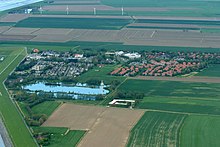Flak battery Kilwa

The heavy flak battery Kilwa in Tossens was a bunkered position of the naval flak in the north of Butjadingen during the Second World War .
construction
The core of the facility consisted of four gun bunkers in the middle of which was a guide bunker. Another guide bunker was outside the facility, there was also an ammunition bunker and a marshal bunker.
Organizational integration
The German Bight Coast Commander was responsible for the coastal defense . The battery belonged as part of the II. Marine Flakbrigade to the Wilhelmshaven section. The flak battery belonged to Navy Flak Division 272, whose Flakuntergruppenkommando Ost was in Tossens.
history
The battery was built in the spring of 1936 on the farmland of the farmer Theodor Friedrich Hansig. The land was part of an hereditary farm and for this reason was inalienable, which is why the Nordenham ancestral court had to agree to the forced sale. The land was then expropriated by the Reich Ministry of War for "imperative reasons of national defense". The facility was used to train naval artillery . The plant's ammunition bunker was camouflaged as a farmhouse. A single-storey U-shaped building complex was built to accommodate the soldiers.
The Kilwa battery initially consisted of a field position with four 8.8 cm anti-aircraft guns and was located at the position of today's holiday apartments; it was ready for action on September 13, 1939. At the end of the same month, a bunker battery was completed 250 meters further west behind the Tossenser sea dike. Due to the 35 ° offset of the 1st gun bunker and the control room to the other bunkers, the system was nicknamed "the inclined battery".
In January 1941, a flight alarm device and a radio measuring device were installed on control station 2 . The battery's ceiling shields were not retrofitted until October 1942.
post war period
After the war, the Tossens battery was blown up by the occupying forces. Today a former farm building and garage building of the external sub-group command area are still present. After the war, displaced persons from the eastern German regions found accommodation in the team buildings. In 1990 the German Youth Hostel Association had the building repaired for 570,000 marks. In 2010 the building was sold and holiday apartments were then furnished.
Armament
Initially, the anti-aircraft battery was equipped with 8.8 cm anti-aircraft guns of the L / 45 type in MPL C / 13. Later a bunkered position was set up, which consisted of four above-ground gun bunkers, each of which had a 10.5 cm gun . There was also a Würzburg type radar .
literature
- Friedrich August Greve: The air defense in the Wilhelmshaven section 1939-1945. 2nd Navy Flak Brigade. Hermann Lüers, Jever 1999, ISBN 3-9806885-0-X .
Individual evidence
- ^ A b c Friedrich August Greve: The air defense in the Wilhelmshaven section 1939–1945. 2nd Navy Flak Brigade . Hermann Lüers, Jever 1999, ISBN 3-9806885-0-X , p. 16 .
- ↑ a b c d Friedrich August Greve: The air defense in the Wilhelmshaven section 1939-1945. 2nd Navy Flak Brigade . Hermann Lüers, Jever 1999, ISBN 3-9806885-0-X , p. 217 f .
- ^ Friedrich August Greve: The air defense in the Wilhelmshaven section 1939-1945. 2nd Navy Flak Brigade . Hermann Lüers, Jever 1999, p. 48 .
- ↑ a b Rolf Bultmann: In the future twelve holiday apartments. Retrieved October 29, 2019 .
- ↑ a b Flak positions in the Wilhelmshaven area and the immediate vicinity. Retrieved November 2, 2019 .
- ↑ The Wesermarsch in the war . 2014, p. 67 .
Coordinates: 53 ° 34 ′ 16.4 " N , 8 ° 14 ′ 33.4" E

